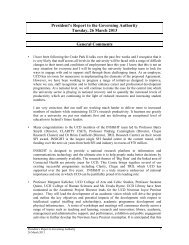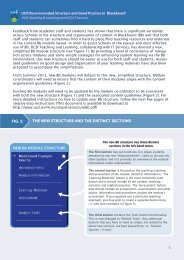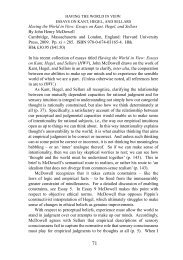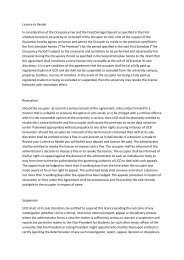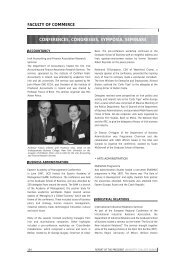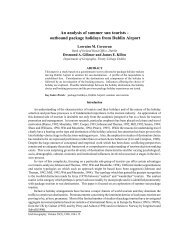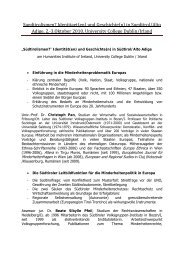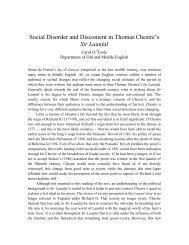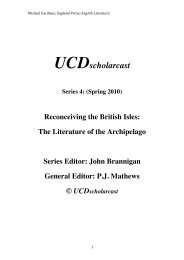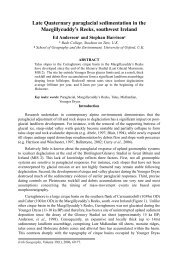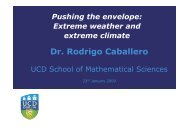Weaving the labyrinth of the text — the novel poetics of Goethe's ...
Weaving the labyrinth of the text — the novel poetics of Goethe's ...
Weaving the labyrinth of the text — the novel poetics of Goethe's ...
Create successful ePaper yourself
Turn your PDF publications into a flip-book with our unique Google optimized e-Paper software.
The <strong>labyrinth</strong> has long been used as a metaphor for <strong>the</strong> difficult <strong>text</strong> or discussion:<br />
both in a pejorative sense to denote arguments which were unnecessarily complicated;<br />
and positively for <strong>the</strong> dialectic by which <strong>the</strong> wise teacher leads <strong>the</strong> student through <strong>the</strong><br />
necessarily winding paths towards knowledge and understanding. In <strong>the</strong> Middle Ages <strong>the</strong><br />
term ‘Aristotle’s <strong>labyrinth</strong>’ was used to denote a difficult philosophical <strong>text</strong>. Goe<strong>the</strong>, too,<br />
uses <strong>the</strong> image in this sense. In an essay he describes how, when he began to read Kant’s<br />
Kritik der reinen Vernunft he experienced for <strong>the</strong> first time <strong>the</strong> attraction <strong>of</strong> a <strong>the</strong>oretical<br />
work, but never<strong>the</strong>less felt unable to enter fully into <strong>the</strong> <strong>labyrinth</strong> <strong>of</strong> <strong>the</strong> <strong>text</strong>:<br />
... nun aber schien zum erstenmal eine Theorie mich anzulächeln. Der Eingang war es der mir gefiel,<br />
in’s Labyrinth selbst konnt’ ich mich nicht wagen (W.A. 2.11, p. 49).<br />
[... now for <strong>the</strong> first time, however, a <strong>the</strong>ory seemed to smile invitingly at me. It was <strong>the</strong> entrance<br />
that attracted me, but I didn’t dare to venture into <strong>the</strong> <strong>labyrinth</strong> itself.]<br />
Both <strong>the</strong> <strong>labyrinth</strong> and <strong>the</strong> intricately woven fabric are ambivalent images, suggesting<br />
both order and chaos, harmony and threat. <strong>Weaving</strong> can create an intricate ordered whole<br />
out <strong>of</strong> a multitude <strong>of</strong> threads, but it can also create a net, a web to entrap <strong>the</strong> unwary. The<br />
<strong>labyrinth</strong> is a motif which has had an incomparable fascination for artists and writers<br />
from ancient times to <strong>the</strong> present day. It is at one and <strong>the</strong> same time a symbol <strong>of</strong> chaos<br />
and a symbol <strong>of</strong> cosmos. On <strong>the</strong> one hand <strong>the</strong> <strong>labyrinth</strong>-walker runs <strong>the</strong> risk <strong>of</strong> losing<br />
himself in <strong>the</strong> tortuous meandering paths <strong>of</strong> <strong>the</strong> <strong>labyrinth</strong>. It symbolises both <strong>the</strong><br />
subjective confusions inside <strong>the</strong> human mind and also <strong>the</strong> difficult path through <strong>the</strong><br />
objectively existing world around. On <strong>the</strong> o<strong>the</strong>r hand <strong>the</strong> <strong>labyrinth</strong> represents a complex<br />
order in diversity <strong>—</strong> a cosmos, for those who view it from outside, from a bird’s eye<br />
perspective. Both <strong>the</strong>se aspects <strong>of</strong> <strong>the</strong> <strong>labyrinth</strong>, as chaos and as cosmos, are used<br />
frequently by Goe<strong>the</strong> throughout his writings. Looking back in 1821 over <strong>the</strong> previous<br />
sixty years he uses <strong>the</strong> image in a satirical epigram to describe <strong>the</strong> increasing<br />
complexities <strong>of</strong> <strong>the</strong> world he inhabits:<br />
Seit sechzig Jahren seh’ ich gröblich irren<br />
Und irre derb mit drein;<br />
Da Labyrin<strong>the</strong> nun das Labyrinth verwirren,<br />
Wo soll euch Ariadne sein? (W.A. 3, p. 253).<br />
[For sixty years I’ve watched as all went far astray<br />
And have myself strayed with <strong>the</strong> rest;<br />
Since <strong>labyrinth</strong>s without end confuse <strong>the</strong> <strong>labyrinth</strong>,<br />
Where will we find a new Ariadne?]<br />
In his autobiographical work Dichtung und Wahrheit he suggests that literature can<br />
<strong>of</strong>fer its readers <strong>the</strong> possibility <strong>of</strong> <strong>the</strong> bird’s eye perspective which makes cosmos out <strong>of</strong><br />
chaos:



